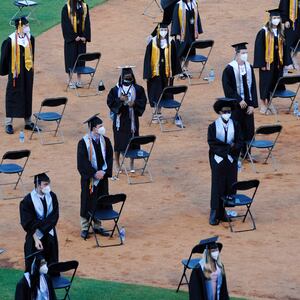The death of a patient at the hands of the novel coronavirus is a tragedy for any doctor. But it was especially jarring in an otherwise healthy man in his fifties who contracted the infection at a recently reopened restaurant in Montgomery, Alabama—a place he likely felt safer venturing after testing positive for antibodies, local pulmonologist and critical care doctor David Thrasher recalled in an interview.
The man first got sick with COVID-19 while traveling in Europe six months earlier, before it hit North America with a vengeance, Thrasher explained. Federal law prohibited him from providing details about the case, but he said the disturbing death confirmed for him and his colleagues in Alabama, where infections have surged in recent weeks, what they’d already feared: No one is safe.
“There’s some limited immunity, but we don’t know how long it lasts,” Thrasher told The Daily Beast. “Don’t get fat and happy thinking you can’t get it.”
Over the course of last Thursday to Monday, Thrasher treated 78 patients, the “grand majority” of whom were suffering from severe cases of COVID-19. Of that group, many were on ventilators. Between himself, another doctor, and a nurse practitioner, the team treated 140 patients at four hospitals, he said. That’s more than double their normal summer caseload, and the patients are getting younger and younger, ranging from their twenties to their seventies.

As of Wednesday, Alabama had 70,358 confirmed cases and 1,303 deaths from the virus. Across the state, 8,538 people had been hospitalized, with 1,547 currently in beds. The last available federal data for use of the state’s ICU capacity put Alabama at 82.6 percent on July 7. State data for test positivity rates put Alabama at 16.8 percent on July 11—double the national rate as of Wednesday.
Earlier this month, Alabama hit a peak of more than 2,000 new infections, and like many other states, the trend has been headed in the wrong direction.
The physical and mental toll in a seemingly endless battle have frontline doctors all over the state feeling overwhelmed. One source of hope: a recently-enacted statewide face mask mandate. But medical providers and public health experts in Alabama are running up against deep-rooted cultural conservatism that’s making their already difficult jobs even harder.
The alarm goes off in Thrasher’s red-brick home in Montgomery at 4 a.m. on weekend mornings. He grabs his green scrubs, blue gloves, N100 mask, and face shield, and walks out the door. Some days, he doesn’t return until 8 p.m. with his face bruised from the equipment and his nose bleeding. When he’s on call, he’s getting beeped throughout the night—about COVID-19 patients, about their charts, about their ventilators.
“The volume is incredible. We’ve lost people in their twenties and several in their thirties,” said Thrasher, who cited the recent death of a 21-year-old. “Some of these people have zero comorbidities.”
Dr. Anthony Fauci, the public face of the White House’s coronavirus response and the director of the National Institute of Allergy and Infectious Diseases, told The New York Times this week that the age average for new cases in the South are “about 10 to 15 years younger than what we previously saw”—a trend that was first flagged by researchers in Washington state.
“They are fueling the pandemic,” said Fauci. “We have to keep hammering that home, because, as much as they do that, they’re completely relinquishing their societal responsibility.”
For the weeks patients spend in Montgomery hospitals, they are limited primarily to contact with a nurse—whom Thrasher called “their only bridge to the outside world and their only hope”—and otherwise speak to doctors and family through glass or video conferences. The nurses, said Thrasher, are “the heroes of the world.” They’re routinely getting infected themselves or, over exposure concerns, taken out of rotation and put in quarantine, he said. Those who don’t become infected are still often prone to breakdowns over the emotional and physical toll, which makes staffing difficult to maintain, he said.
As has been widely reported in other parts of the South, Montgomery Mayor Steven Reed’s office told The Daily Beast on Wednesday that a majority—and disproportionate percentage—of cases in the city have affected Black residents.
“The death and dying is nothing like we’ve ever seen before,” said Thrasher, who has practiced medicine since 1983 and previously worked as a coroner. “We're used to people dying, but this is different.”
On Tuesday, a few hours before he spoke to The Daily Beast, Thrasher told yet another woman that her father had died. The rest of any given day disappears quickly, he said: “You go and see these patients, you adjust ventilators, you go over the case with the pharmacist, the respiratory therapists, the nutritionists, and you just keep going, take a break to grab a sandwich about noontime, and then you keep going until late in the evening.”
Dr. Michael Saag, a friend of Thrasher’s—and the associate dean for global health at the University of Alabama at Birmingham and an expert in infectious diseases who spends his days tending to patients at a COVID-19 outpatient clinic—said he could not get the concept of 78 patients out of his head.
“If you spent 10 minutes per patient, that’s over 12 hours of rounding,” Saag told The Daily Beast this week. “That doesn’t include the time reading the chart, writing notes, meeting with families. It’s darn near impossible to do that day in and day out and not become exhausted and overwhelmed.”
Saag speaks from personal experience: He contracted the virus in early March after a trip to Manhattan and suffered eight nights of acute symptoms, he said.

“The worst part of it was not knowing what was going to happen next,” said Saag. “I’d be short of breath and having coughing spells and fever, and I knew as a physician that I wasn’t sick enough to require hospitalization—but I didn’t know what the next 15 minutes would bring. In the wee hours of the morning, it was horrifying, and that went on for eight days in a row.”
When the push came in May to relax stay-at-home orders in Alabama, Saag told The Daily Beast, “Unfortunately, a lot of folks thought that was a green light to go back to life as we knew it.”
After a surge, several cities imposed local ordinances. Counties did the same, and last week, Gov. Kay Ivey ordered a statewide mask mandate. As Ivey has repeatedly said publicly, she believes the order will be hard to enforce, since some local law enforcement officials say they don’t feel comfortable with it.
Karen Landers, a doctor at the Alabama Department of Public Health, said on Tuesday that, while businesses—including restaurants—are still allowed to remain open, there are more than 10 pages of restrictions on capacity and social distancing measures in Ivey’s orders. Landers called mask-wearing “one of the most important measures” to turn around the tide of cases, considering the current numbers and the fact that eight counties don’t have hospitals at all.
At this point, Landers added, it’s difficult to isolate epidemiological links to the state’s case count. “The overarching issue,” she said, “is widespread community transmission” across the state.
This week, the White House Coronavirus Task Force credited a dramatic decrease in Arizona’s cases to the widespread use of masks and increased social distancing, as well as the closure of bars and the reduction of restaurant capacity. Vice President Mike Pence encouraged other states to follow Arizona’s “leadership,” even as that call came after months of Gov. Doug Ducey’s refusal to implement a statewide mandate. (Ninety percent of the state has local mask ordinances, even without an order from Ducey.)
“Masks, closing indoor bars, decreasing indoor dining capacity to 25 percent, continued social distancing and personal hygiene messaging, according to the model, dramatically decrease the rate of community spread,” Pence, chair of the White House task force, said in a meeting with governors this week, according to a recording obtained by The Daily Beast.
But Pence’s encouragement of mask-wearing came after the White House—and Trump specifically—long called into question the effectiveness of masks. Trump himself refused to wear one in public until a few weeks ago, though he recently claimed using a face covering is “patriotic,” and brandished one during a White House briefing on Tuesday.
Saag, who identifies as a conservative, said the mixed messaging has only added to the open distrust of public health officials.
Likewise, Thrasher bemoaned the life and death effects of a simmering—and to his mind unnecessary—culture war.
“I get it, OK?” he opined. “Nobody likes the government telling you what to do. But they tell us we have to wear seat belts, that we can’t drink and drive. How is this different? It’s very frustrating.”
The lifelong conservative and Auburn University graduate said he’s been called a “Pelosi liberal” in recent weeks over his sober take on the virus and on mask guidance.
“It’s not Auburn vs. Alabama,” he said, adding, “We’re all on the same team.” And without public buy-in on masks, social-distancing, and hand hygiene, it’s sometimes hard for him to keep his hopes up.
As Thrasher put it, “I don’t see any light at the end of the tunnel right now.”



